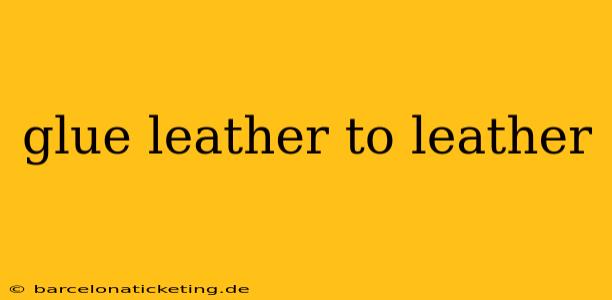Gluing leather to leather might seem daunting, but with the right techniques and adhesives, it's a manageable task, yielding strong, durable bonds. This guide delves into the process, addressing common concerns and offering expert advice for achieving professional-looking results. Whether you're repairing a favorite bag, crafting a new leather item, or undertaking a restoration project, mastering leather-to-leather bonding is a valuable skill.
What Kind of Glue is Best for Leather?
Choosing the right adhesive is crucial for a successful bond. Several options excel at adhering leather, each with its own strengths and weaknesses:
-
Contact Cement: This is a popular choice for its strong, immediate bond. It's ideal for large surfaces and requires precise application, as adjustments are difficult once the surfaces touch. Always ensure proper ventilation when using contact cement, as the fumes can be strong.
-
Barge Cement: Known for its exceptional holding power, Barge Cement is a versatile option suitable for various leather types and projects. Similar to contact cement, precision is key.
-
Leather Glue: Specifically formulated for leather, these glues offer good adhesion and flexibility. They often come in tubes, allowing for precise application. This is a great option for beginners due to its ease of use and less pungent odor.
-
Epoxies: While more time-consuming to work with due to curing times, epoxies provide a very strong bond that's resistant to water and various chemicals. They are excellent for high-stress applications.
What Glue Should I NOT Use on Leather?
Avoid using general-purpose PVA glues (like white wood glue) on leather. They lack the flexibility needed for leather's movement, leading to cracking and bond failure over time. Superglue can also be problematic, potentially leaving visible residue and creating a brittle bond.
How to Prepare Leather for Gluing
Proper preparation is vital for a lasting bond. Follow these steps:
-
Clean the Surfaces: Remove any dirt, grease, or debris from both leather surfaces using a clean cloth and a mild detergent. Allow the leather to dry completely.
-
Roughen the Surfaces (Optional but Recommended): For maximum adhesion, lightly scuff the surfaces with fine-grit sandpaper (around 220-grit). This increases the surface area for the glue to grip. Be gentle to avoid damaging the leather.
-
Apply the Glue: Follow the manufacturer's instructions for your chosen glue. For contact cements, typically, you'll apply a thin, even coat to both surfaces, allowing them to "tack" (become slightly sticky) before joining. Leather glues usually require application to one surface only.
-
Clamp or Weight: Securely clamp the glued surfaces together, ensuring even pressure is distributed across the entire area. If clamping isn't feasible, use heavy weights to apply pressure. Allow ample curing time as specified on the glue packaging.
How Long Does Leather Glue Take to Dry?
Drying times vary depending on the type of glue, temperature, and humidity. Always refer to the manufacturer's instructions for accurate drying times. Typically, it can range from a few hours to overnight.
Troubleshooting Common Problems
-
Glue Showing Through: This often happens with improper application. Use a very thin coat of glue and ensure that it's fully absorbed or has dried prior to clamping.
-
Bond Failure: This is often due to inadequate surface preparation, incorrect glue selection, insufficient pressure during curing, or premature use of the bonded item.
-
Cracking: This indicates a lack of flexibility in the adhesive. Using a glue designed specifically for leather is crucial.
Tips for Success
- Practice on Scraps: Test your chosen glue and technique on leather scraps before working on your project.
- Work in a Well-Ventilated Area: Many leather glues have strong fumes.
- Use Clamps or Weights: Consistent pressure is essential for a strong bond.
- Patience is Key: Allow sufficient curing time for the glue to fully set.
By following these guidelines and selecting the right glue, you'll be able to confidently glue leather to leather, creating lasting and professional results. Remember, preparation and the right adhesive are the keys to success!

